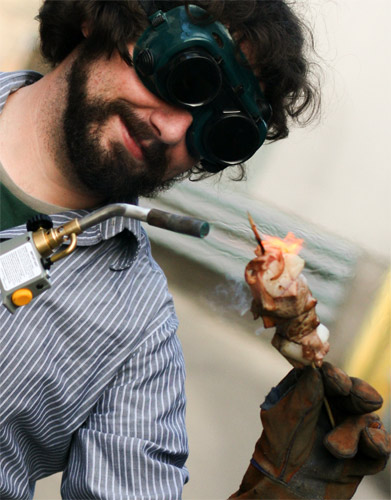 Changing systems with heat
Changing systems with heat
Read Chapter 4
Heat Capacities
Heat capacity: (limiting ratio of) heat supplied, $\Delta Q$, divided by the change in temperature, $\Delta T$. $$C = \frac{\delta Q}{dT}.$$
- $\Delta Q$ is an extensive quantity: Usually we'll look instead at the specific heat capacity per kilomole.
- We haven't specified a path, but we know that $\delta Q$ is not an exact differential.
The two kinds of paths we'll consider are: $$c_v \equiv \frac{1}{n} \left( \frac{\delta Q}{dT} \right)_v = \left( \frac{\delta q}{dT} \right)_v \ ;\ c_P \equiv \left( \frac{\delta q}{dT} \right)_P.$$
Now, consider the internal energy function $u$:
- $u$ is a state function,
- $\Rightarrow$ specifying any 2 thermodynamic parameters is enough to uniquely determine the state and any function of the state.
- Your choice! $u(P,v)$, or $u(T,v)$, or $u(T,P)$.
Choosing $u(T,v)$: $$du = \left( \frac{\partial u}{\partial T} \right)_v dT + \left( \frac{\partial u}{\partial v} \right)_T dv.$$
For a constant volume process, the second term vanishes, leaving: $$\left( du \right)_v = \left( \frac{\partial u}{\partial T} \right)_v dT.$$
According to the 1st Law, $du=\delta q -\delta w$. For a reversible process $\delta w = P\,dv$: $$du = \delta q-P\,dv \Rightarrow \left( du \right)_v = \delta q.$$
Taking the last two expressions for $du$ in constant-volume processes, gives $$\delta q = \left( \frac{\partial u}{\partial T} \right)_v dT.$$
Or, $$\left( \frac{\delta q}{\partial T} \right)_v = \left( \frac{\partial u}{\partial T} \right)_v.$$
So,
$$c_v = \left( \frac{\partial u}{\partial T} \right)_v.$$
Integrating: $$(\Delta u)_v=\int (du)_v = (u-u_0)_v = \int_{T_0}^{T} c_v dT.$$
- This holds for any substance undergoing a constant-volume process.
- $c_v$ can be temperature dependent.
Problem (Carter 4-1): The specific heat capacity $c_v$ of solids at low temperature is given by the Debye T${}^3$ law: $$c_v = A \left( \frac{T}{\theta}\right)^3.$$
- $A$ is a constant where $A=19.4 \times 10^5$ J kilomole${}^{-1}$ K${}^{-1}$,
- $\theta$ is called the Debye temperature. For NaCl $\theta = 320$K.
b.) How much heat is required to raise the temperature of 2 kilomoles of NaCl from 10 K to 50 K at constant volume?
c.) What is the mean specific heat capacity at constant volume over this temperature range? (BTW: it is *not* the average of $c_v(T=10 K)$ and $c_v(T=50 K)$.)
We shall shortly see that, for an ideal gas, the internal energy actually depends only on temperature, i.e. $u(T,v) = u(T)$, not on volume at all. When this is true, then we can axe the subscript from the partial derivative, and also dispense with the partial derivatives, and just write: $$c_v = \frac{du}{dT} \text{ (ideal gas)}.$$
Integrating like this: $$\Delta u = \int du = u-u_0 = \int_{T_0}^{T} c_v dT.$$
- This expression holds only for ideal gases, for which the internal energy depends only on $T$ (and not at all on $V$).
- But this expression, when used for ideal gases, is not limited to constant volume processes, since $u(T)$ depends exclusively on temperature.
Problem (Carter 4-6 a): To a good approximation Oxygen behaves like an ideal gas with $c_v=(5/2)R$.
Suppose that the temperature of 2 kilomoles of O${}_2$ is raised from 27 C to 227 C. What is the increase in internal energy?
Image credits
Anne Petersen